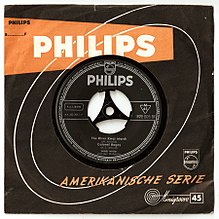Colonel Bogey March
The Colonel Bogey March is a world famous military march . It was written in 1914 by the British military music bandmaster Frederick Joseph Ricketts (better known by his stage name Kenneth J. Alford ). The march became known through the film " The Bridge on the Kwai " from 1957, in which the prisoners of war whistle the melody of the march.
During the Second World War, the march in England and the USA was often sung with vulgar mockery texts, such as "Hitler has only got one ball" (" Hitler has only one egg ").
Malcolm Arnold composed the March from the River Kwai for the film in 1957 , which is an instrumental counter-melody to the Colonel Bogey March whistled in the film . The march is known as the March from the River Kwai and is still associated with the war film today. Mitch Miller arranged a medley of both marches, which can be heard at the end of the film. The medley consists of the melody of Colonel Bogey March laid over the orchestrated River Kwai March .
In 1958, The River Kwai March - Colonel Bogey , so the full title, was a No. 1 hit in Germany and a top 20 hit (as March from the River Kwai and Colonel Bogey ) in the USA. Because of the popularity of this Mitch Miller medley, the Colonel Bogey March and its melody are often incorrectly called the River Kwai March and River Kwai March, respectively . In several films, the melody is also whistled in appropriate situations, e.g. B. from the detainees at The Breakfast Club or the dinks at Mel Brooks' Spaceballs . Later it was used as an advertising melody for Underberg -Bitter (“Come with me to the Underberg!”).
In Switzerland the following question is sung to the melody: “Frölein, do you mean my doggie gseh?” - “Nenei, da Cheib isch niene meh!” ( Miss, have you seen my doggie? - No, no, the guy is nowhere more! ).
Individual evidence
- ^ Joel Whitburn: The Billboard Book of Top 40 Hits . 7th edition. Billboard Books, New York 2000, ISBN 0-8230-7690-3 , p. 429.
